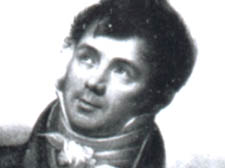|
|
 |
| |

Fernando Sor 1778-1839 |
Stirring songs of Spain, two centuries later
Catalan composer Fernando Sor moved to Camden after being drawn into politics by invading armies, writes Fiona Green
TWO hundred years ago in May, there was a huge uprising in Spain, and England was the destination of a wave of Spanish refugees to make this their home until they could return.
One such was the composer, Fernando Sor. He lived at 26 Charlotte Street in 1822.
So many refugees, like Sor, came to London at this time, and so many lived in a part of Somers Town (now occupied by Euston station) that the English nightwatchman used to call out the time in Spanish.
Sor was in touch with these exiles, and it was through this political context that his music first became known in England, where he performed at concerts as a singer and a guitarist.
In 1808, however, as an army officer, Sor was living in Spain. A Catalan by birth, he was in Malaga.
He was a guitarist and composer, who played in concerts. But the arrival of Napoleon’s troops in Spain changed his ordered way of life. Until then, he had not taken part in politics, but now, as a loyal Spaniard, he chose to become involved.
He started composing patriotic and martial songs against the French – with the poet Arriaza – who wrote the accompanying lyrics.
From 1808-1813 while his contemporary, Goya, was producing one of his finest works, The Disasters of War, Sor composed some of the most famous political songs of the time. When the French entered Madrid, Sor went there too, from Andalusia.
Although the insurrection was put down, and bloody reprisals followed, it roused the rest of Spain. And further south there was even a brief victory at Bailen.
Joseph Bonaparte (brother of Napoleon) fled and the Spanish marched triumphantly into Madrid to Sor’s song Venid Vencedores (Himno de la Victoria).
It later seems to form the basis for Hymn of Riego, sung by the Brigades fighting alongside the Spanish against Franco and his German and Italian fascist allies in the 1930s.
This is the year which marks the bi-centenary or 200 years of Spanish national identity celebrated especially in Madrid.
On May 2, 1808 – or Dos de Mayo, also the title of a Goya painting – the people of Madrid rose up against the occupying French troops.
They were heroic, and unsuccessful, but it was the spark which set off the Spanish War of Independence.
Emperor Napoleon Bonaparte, who was at war with Britain, had imposed a blockade to cut off trade with the continent of Europe and, to enforce this, he moved in on Spain.
There was an uprising in Aranguez in March 1808, but it was when the French crossed Madrid, to take the young prince Carlos, later, on May 2, that the people of Madrid – or madrillenos – took to the streets and attacked all French soldiers on sight.
Eventually, the French regained control and the reprisals began.
Goya’s famous painting El Tres de Mayo depicts the executions which took place immediately.
This war in Spain was interesting, because the presence of French troops provoked an unusual response – “guerrilla warfare” (Spanish for “little war”).
It is an example of an entire people spontaneously resisting a foreign occupation and a war for Spanish independence – perhaps a model for later wars and anti-collonial movements such as the Vietnamese opposition to the United States in the 1960s.
Si Dices Que Mis Ojos
|

|
 |
|
 |
|

